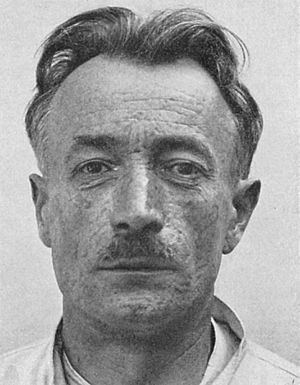František Kupka facts for kids
Quick facts for kids
František Kupka
|
|
|---|---|

František Kupka, circa 1928
|
|
| Born | 23 September 1871 Opočno, Austria-Hungary (now in the Czech Republic)
|
| Died | 24 June 1957 (aged 85) |
| Nationality | Czech |
| Education | Academy of Fine Arts in Prague Academy of Fine Arts Vienna Académie Julian École des Beaux-Arts |
| Known for | Painting |
František Kupka (born September 23, 1871 – died June 24, 1957) was a famous Czech painter and graphic artist. He is known for being one of the first artists to create abstract art. Kupka also helped start a style called Orphic Cubism, or Orphism.
His early paintings looked very real, like photographs. But over time, his art changed. It became completely abstract, using shapes and colors instead of real-world objects.
Contents
About František Kupka
Early Life and Learning
František Kupka was born in 1871 in Opočno, a town in what was then Austria-Hungary. Today, this area is part of the Czech Republic.
From 1889 to 1892, he studied art at the Academy of Fine Arts in Prague. During this time, he painted pictures about history and his home country. Later, he went to the Academy of Fine Arts in Vienna. There, he focused on symbolic art, which uses images to represent ideas, and allegorical art, which tells a story through symbols.
Kupka was interested in theosophy, a spiritual philosophy, and ideas from Eastern philosophy. In 1894, he moved to Paris, France. He continued his art studies at the Académie Julian and the École des Beaux-Arts.
Artistic Journey
When he first moved to Paris, Kupka worked as an illustrator. He drew pictures for books and posters. He also became known for his funny drawings in newspapers and magazines.
In 1906, Kupka moved to Puteaux, a suburb of Paris. That same year, he showed his art for the first time at the Salon d'Automne, a big art exhibition. He was very impressed by the first Futurist Manifesto, a declaration by artists who wanted to show movement and speed in their art.
Around 1910, Kupka's art started to become more and more abstract. He explored his ideas about motion, color, and how music and painting are connected. This led to his unique style called Orphism. In 1911, he joined meetings of the Puteaux Group, a group of artists interested in new art forms.
In 1912, Kupka showed his painting Amorpha. Fugue à deux couleurs at the Salon des Indépendants. Even though it was in the Cubist room, Kupka did not want his art to be limited to just one art movement.
In 1931, Kupka helped start a group called Abstraction-Création. This group promoted abstract art. His work was shown in important exhibitions, including "Cubism and Abstract Art" at the Museum of Modern Art in New York City in 1936. He also had a show with another famous Czech painter, Alphonse Mucha, in Paris.
Kupka continued to show his art regularly until he died in 1957 in Puteaux, France. In his later years, he became widely recognized for his important contributions to art.
His Ideas About Art
Kupka was very interested in how colors work. He wanted to use colors in his art without them having to represent real things. For example, his painting The Yellow Scale (around 1907) was mostly about the color yellow itself, even though it was a self-portrait.
He also created his own color wheels, similar to those used by scientists like Isaac Newton. This led him to paint a series of works called "Discs of Newton" (1911–12).
Some of his well-known works include:
- Planes by Colors
- The Colored One
- Reminiscence of a Cathedral
- Blue Space
- The Cathedral (Katedrála)
In March 2021, one of Kupka's paintings, Le Jaillissement II, sold for a very high price of over 7.5 million British Pounds. This shows how valuable and important his art is considered today.
Personal Interests
Kupka was a vegetarian. He was also very interested in theosophy, a spiritual belief system. He believed in "thought-forms," which are ideas or feelings that can take on a visible shape. These ideas influenced his artwork, including his "Disks of Newton" paintings.
See also
 In Spanish: František Kupka para niños
In Spanish: František Kupka para niños
- Kupka and Theosophy



